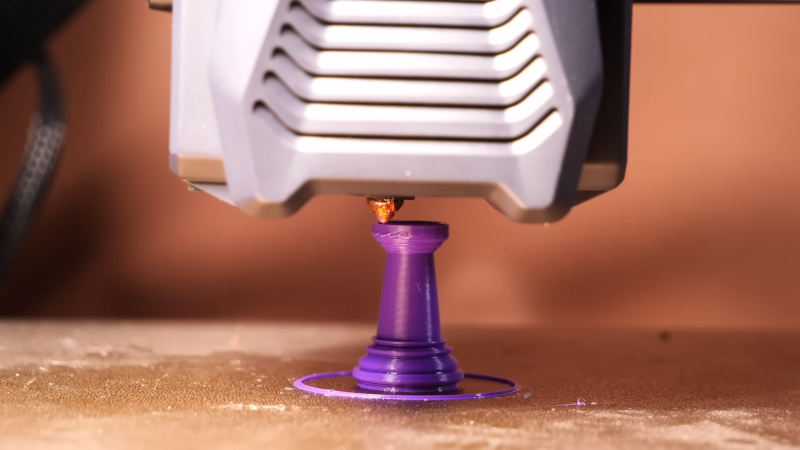Normally, 3D printing with filament takes temperatures of around 200 °C. However, there are some crafting plastics that melt in hot water at 60 °C. You can get spools of similar plastic that prints at very low temperatures, and some 3D printing pens use it. [Lost in Tech] picked up a spool of the stuff meant for medical printing and found that printing with it was a challenge. You can watch a video of the results below.
The first problem is that most printers don’t want to extrude at low temperatures. You can override this or, if you want to print with this plastic — PCL — you can rebuild the printer firmware. He never got bridges to work very well, but some prints came out reasonably well.
Of course, you might wonder why you would care about this kind of plastic. For one thing, it’s apparently safe to work with. If you were printing with students, too, you might be interested in a lower printer temperature. However, it didn’t look like the results were that good. However, it makes you wonder what kinds of filament you could use with a little work that might have some benefit.
The last time we heard about this stuff, someone was printing bones with it. We are always on the lookout for oddball filament to play with.

















I think the “Moldlay” filament – designed for printing molds you can dissolve easily with heat – is (or was, not sure it’s still made ?) printed at even lower temperatures.
Nope sorry not Modlay, it was around 170°C – I’m pretty sure there was another one like this needing less temperature.
What about a Metall particle reinforced Filament? And instead of the Heater nozzle a Induktion heater?
Or complete Induktion Heater füll metal rod 3d printing.
Good luck laying that down uniformly. It would probably work more like an inkjet printer, spewing around plastic fumes and red hot metal particles.
I think I’ve seen a welder (MIG? not sure) on a robot arm being used as a 3d printer. It was cool, not much more than that.
Next step…
https://www.belmontmetals.com/product/rose-metal-203-239-f-95-119-c-low-melting-alloy/
“50% bismuth, 25–28% lead and 22–25% tin.”
Yeah… so just how much brain damage did you want?
I don’t think you’re meant to eat it.
now you tell me
There are plenty of low melt fusible alloys of bismuth which don’t contain lead. For example: https://www.rotometals.com/roto117f-low-melt-fusible-bismuth-based-ingot-alloy-ingot/
Did you grow up eating lead paint chips or something?
Its not plutonium, settle down.
Im almost 50, been refining gold with lead for over half my life. Just got a clean bill of health on my annual physical. Theres a right way and a wrong way to do most anything. Stop chicken littling
PCL is one of the first materals a reprap ever extruded, with primitive filament rods made by rolling the heated plastic between sheets of glass…
Polycaprolactone aka Shapelok(TM)
“Safe for plastic”?
Print in wax… Then do lost wax casting.
Another use case for developing lower-temp printing would be reducing lower energy use – at least with our largely fossil-fueled grid the energy impact of printers maintaining hot end and bed temp is staggeringly high!
You’re setting a pretty low bar for “staggeringly high!” You can insulate the build chamber if the energy impact is making it difficult for you to stand. :)
Did you grow up eating lead paint chips or something?
Its not plutonium, settle down.
Im almost 50, been refining gold with lead for over half my life. Just got a clean bill of health on my annual physical. Theres a right way and a wrong way to do most anything. Stop chicken littling
Come back when your 70, if you can remember how to go to a website with all that Alzheimer’s…
Come back when youve got at least enough intelligence to comprehend safe handling proceedures exist for EVERYTHING, even Plutonium.
A cupola absorbs the vast majority of the lead. Anything that escapes the furnace goes into the hood vent. Regardless of metal composition, You dont breathe molten metal fumes. If you dont know that much by now, Youre beyond help. Good Luck Kid, your gonna need it
Report comment
Reply
Hmmm… I don’t even like PLA because I know what happens if I accidentally leave it in my car on a summer day.
Come back when youve got at least enough intelligence to comprehend safe handling proceedures exist for EVERYTHING, even Plutonium.
A cupola absorbs the vast majority of the lead. Anything that escapes the furnace goes into the hood vent. Regardless of metal composition, You dont breathe molten metal fumes. If you dont know that much by now, Youre beyond help. Good Luck Kid, your gonna need it
Not sure why my reply’s keep dropping as new comments. Must be all the lead fumes. HAHA Could some moderator please just delete the duplicates. Hell delete it all if you want. Just wasted words anyway.
If bridging is a problem, use. CoreXY layout with top mounted motors for all axes, and submerge the print volume in water. Extrusion will solidify almost instantly in leaving the heated nozzle, so you could likely print support-free.